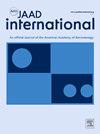Cosmetic and functional outcomes of excisional surgical wounds healed by secondary intention: A systematic review
IF 5.2
引用次数: 0
Abstract
Background
Data regarding short-term and long-term cosmesis and functional outcomes of excisional surgical wounds healed by secondary intention healing (SIH) are limited.
Objective
To conduct a systematic review and assess the cosmetic and functional acceptability of SIH for acute excisional surgical wounds.
Methods
Full-text articles queried from PubMed and Embase databases between January 1964 and April 2024 with cosmetic outcome data of human subjects with acute surgical wounds healed by SIH were included. Preferred Reporting Items for Systematic reviews and Meta-Analyses guidelines were followed.
Results
A total of 1655 surgical wounds, of which 1518 (91.7%) healed by SIH, from 35 studies, were included in this review. The most frequent indication for SIH was a defect resulting from excision of nonmelanoma skin cancer (keratinocyte carcinoma), which was identified in 1439 (86%) of patients. Common sites for SIH included the nose (23.3%), periocular region (15.46%), and forehead (13.5%). The majority of wounds on the forehead, medial canthus, lower eyelid, nasal ala, cheeks, lips, postauricular area, and feet resulted in good to excellent cosmetic results, whereas those on the scalp, nasal dorsum, nasal tip, nasal sidewall, and chin yielded less acceptable cosmetic results. Given the baseline variability in cosmesis of primarily closed wounds in some anatomic locations, however, these data suggest the need for future prospective studies.
Summary
SIH may produce an acceptable cosmetic and functional outcome for selected defects and may be of clinical benefit in the appropriate setting. This must be weighed against the potentially improved cosmesis and more rapid healing seen with primarily closed defects.
手术切除伤口继发性愈合的美容和功能结果:一项系统综述
背景:关于二次意向愈合(SIH)的短期和长期美容和功能结果的数据是有限的。目的系统评价SIH治疗急性外科创伤的美观性和功能可接受性。方法检索1964年1月至2024年4月间在PubMed和Embase数据库中检索的关于SIH治疗急性外科创伤患者美容结局的文章全文。遵循系统评价和荟萃分析指南的首选报告项目。结果本综述共纳入35项研究的1655例外科伤口,其中1518例(91.7%)经SIH愈合。SIH最常见的适应症是由非黑色素瘤皮肤癌(角质细胞癌)切除引起的缺陷,在1439例(86%)患者中发现。SIH的常见部位包括鼻子(23.3%)、眼周(15.46%)和前额(13.5%)。大多数在前额、内眦、下眼睑、鼻翼、脸颊、嘴唇、耳后区域和脚上的伤口获得了良好到极好的美容效果,而那些在头皮、鼻背、鼻尖、鼻侧壁和下巴上的伤口获得了较差的美容效果。然而,考虑到一些解剖部位主要闭合伤口的美容基线变异性,这些数据表明需要进行未来的前瞻性研究。sih可以对选定的缺陷产生可接受的外观和功能结果,并且在适当的环境下可能具有临床益处。这必须与潜在的改进的外观和更快速愈合所看到的主要闭合缺陷进行权衡。
本文章由计算机程序翻译,如有差异,请以英文原文为准。
求助全文
约1分钟内获得全文
求助全文

 求助内容:
求助内容: 应助结果提醒方式:
应助结果提醒方式:


